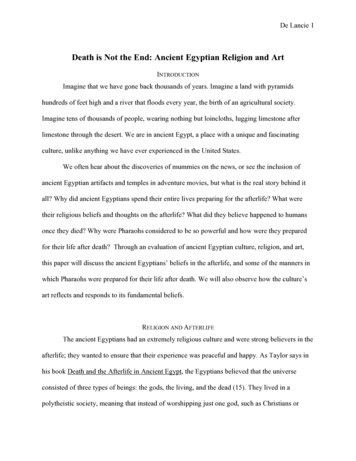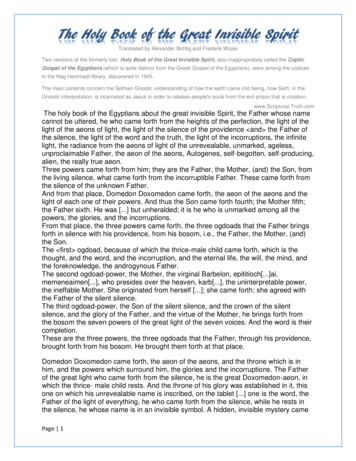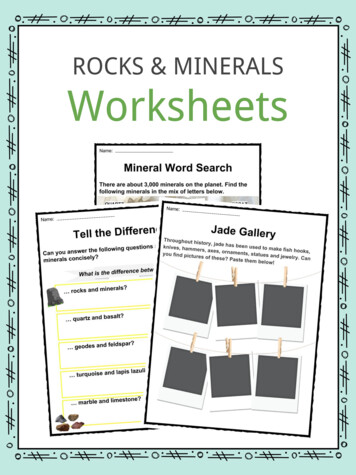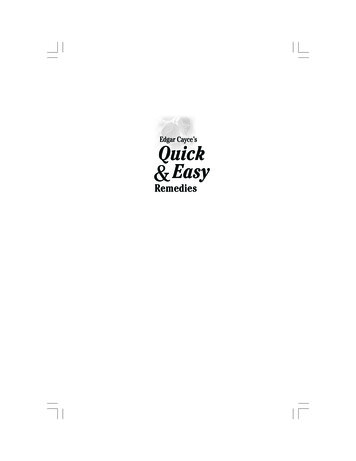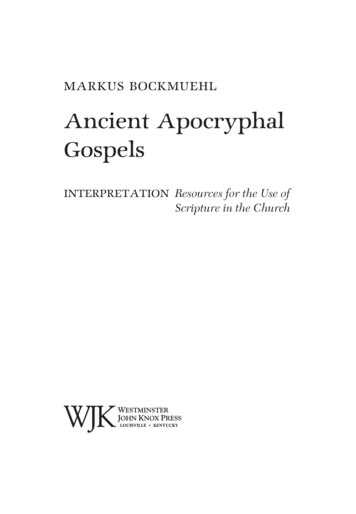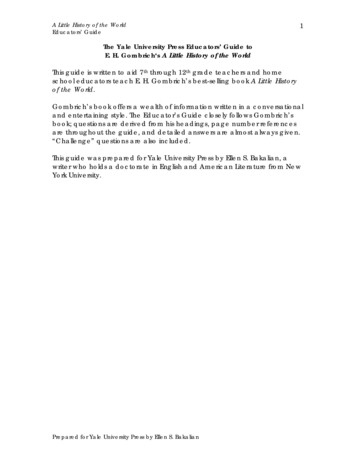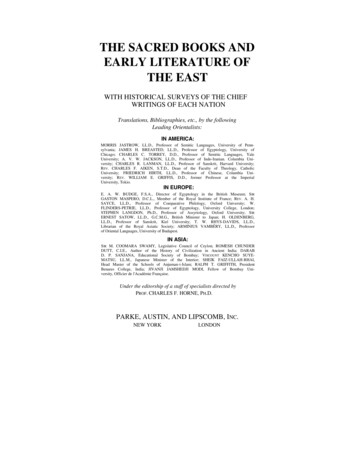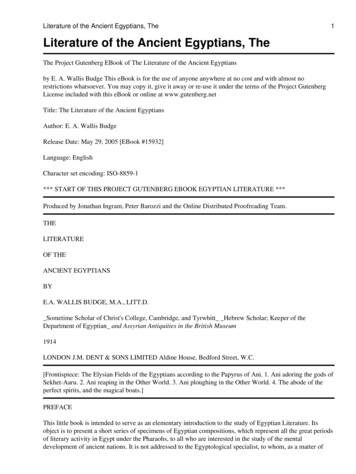
Transcription
Literature of the Ancient Egyptians, The1Literature of the Ancient Egyptians, TheThe Project Gutenberg EBook of The Literature of the Ancient Egyptiansby E. A. Wallis Budge This eBook is for the use of anyone anywhere at no cost and with almost norestrictions whatsoever. You may copy it, give it away or re-use it under the terms of the Project GutenbergLicense included with this eBook or online at www.gutenberg.netTitle: The Literature of the Ancient EgyptiansAuthor: E. A. Wallis BudgeRelease Date: May 29, 2005 [EBook #15932]Language: EnglishCharacter set encoding: ISO-8859-1*** START OF THIS PROJECT GUTENBERG EBOOK EGYPTIAN LITERATURE ***Produced by Jonathan Ingram, Peter Barozzi and the Online Distributed Proofreading Team.THELITERATUREOF THEANCIENT EGYPTIANSBYE.A. WALLIS BUDGE, M.A., LITT.D.Sometime Scholar of Christ's College, Cambridge, and Tyrwhitt Hebrew Scholar; Keeper of theDepartment of Egyptian and Assyrian Antiquities in the British Museum1914LONDON J.M. DENT & SONS LIMITED Aldine House, Bedford Street, W.C.[Frontispiece: The Elysian Fields of the Egyptians according to the Papyrus of Ani. 1. Ani adoring the gods ofSekhet-Aaru. 2. Ani reaping in the Other World. 3. Ani ploughing in the Other World. 4. The abode of theperfect spirits, and the magical boats.]PREFACEThis little book is intended to serve as an elementary introduction to the study of Egyptian Literature. Itsobject is to present a short series of specimens of Egyptian compositions, which represent all the great periodsof literary activity in Egypt under the Pharaohs, to all who are interested in the study of the mentaldevelopment of ancient nations. It is not addressed to the Egyptological specialist, to whom, as a matter of
Literature of the Ancient Egyptians, The2course, its contents are well known, and therefore its pages are not loaded with elaborate notes and copiousreferences. It represents, I believe, the first attempt made to place before the public a summary of the principalcontents of Egyptian Literature in a handy and popular form.The specimens of native Egyptian Literature printed herein are taken from tombs, papyri, stelæ, and othermonuments, and, with few exceptions, each specimen is complete in itself. Translations of most of the textshave appeared in learned works written by Egyptologists in English, French, German, and Italian, but someappear in English for the first time. In every case I have collated my own translations with the texts, and,thanks to the accurate editions of texts which have appeared in recent years, it has been found possible tomake many hitherto difficult passages clear. The translations are as literal as the difference between theEgyptian and English idioms will permit, but it has been necessary to insert particles and often to invert theorder of the words in the original works in order to produce a connected meaning in English. The result of thishas been in many cases to break up the short abrupt sentences in which the Egyptian author delighted, andwhich he used frequently with dramatic effect. Extraordinarily concise phrases have been paraphrased, but themeanings given to several unknown words often represent guess-work.In selecting the texts for translation in this book an attempt has been made to include compositions that are notonly the best of their kind, but that also illustrate the most important branches of Egyptian Literature. Amongthese religious, mythological, and moral works bulk largely, and in many respects these represent the peculiarbias of the mind of the ancient Egyptian better than compositions of a purely historical character. No man wasmore alive to his own material interests, but no man has ever valued the things of this world less incomparison with the salvation of his soul and the preservation of his physical body. The immediate result ofthis was a perpetual demand on his part for information concerning the Other World, and for guidance duringhis life in this world. The priests attempted to satisfy his craving for information by composing the Books ofthe Dead and the other funerary works with which we are acquainted, and the popularity of these works seemsto show that they succeeded. From the earliest times the Egyptians regarded a life of moral excellence uponearth as a necessary introduction to the life which he hoped to live with the blessed in heaven. And even inpyramid times he conceived the idea of the existence of a God Who judged rightly, and Who set "right in theplace of wrong." This fact accounts for the reverence in which he held the Precepts of Ptah-hetep, Kaqemna,Herutataf, Amenemhat I, Ani, Tuauf, Amen-hetep, and other sages. To him, as to all Africans, the OtherWorld was a very real thing, and death and the Last Judgment were common subjects of his daily thoughts.The great antiquity of this characteristic of the Egyptian is proved by a passage in a Book of Precepts, whichwas written by a king of the ninth or tenth dynasty for his son, who reigned under the name of Merikara. Theroyal writer in it reminds his son that the Chiefs [of Osiris] who judge sinners perform their duty withmerciless justice on the Day of Judgment. It is useless to assume that length of years will be accepted by themas a plea of justification. With them the lifetime of a man is only regarded as a moment. After death theseChiefs must be faced, and the only things that they will consider will be his works. Life in the Other World isfor ever, and only the reckless fool forgets this fact. The man who has led a life free from lies and deceit shalllive after death like a god.The reader who wishes to continue his studies of Egyptian Literature will find abundant material in the list ofworks given on pp. 256-8.E.A. WALLIS BUDGE.BRITISH MUSEUM, April 17, 1914.CONTENTSCHAP. PAGE I. THOTH, THE AUTHOR OF EGYPTIAN LITERATURE. WRITING MATERIALS,PAPYRUS, INK AND INK-POT, PALETTE, &c. 1
Literature of the Ancient Egyptians, The3II. THE PYRAMID TEXTS: 9 The Book of Opening the Mouth 13 The Liturgy of Funerary Offerings 16Hymns to the Sky-goddess and Sun-god 18 The King in Heaven 20 The Hunting and Slaughter of the Gods bythe King 21III. STORIES OF MAGICIANS WHO LIVED UNDER THE ANCIENT EMPIRE: 25 Ubaaner and the WaxCrocodile 25 The Magician Tchatchamankh and the Gold Ornament 27 Teta, who restored Life to DeadAnimals, &c. 29 Rut-tetet and the Three Sons of Ra 33IV. THE BOOK OF THE DEAD: 37 Summary of Chapters 42 Hymns, Litany, and Extracts from the Book ofthe Dead 44 The Great Judgment 51V. BOOKS OF THE DEAD OF THE GRÆCO-ROMAN PERIOD: 59 Book of Breathings 59 Book ofTraversing Eternity 61 The Lamentations of Isis and Nephthys 62 The Festival Songs of Isis and Nephthys 64The Book of Making Splendid the Spirit of Osiris 64VI. THE EGYPTIAN STORY OF THE CREATION 67VII. LEGENDS OF THE GODS: 71 The Destruction of Mankind 71 The Legend of Ra and Isis 74 TheLegend of Horus of Behutet 77 The Legend of Khnemu and the Seven Years' Famine 83 The Legend of theWanderings of Isis 87 The Legend of the Princess of Bekhten 92VIII. HISTORICAL LITERATURE: 98 Extract from the Palermo Stone 100 Edict against the Blacks 101Inscription of Usertsen III at Semnah 101 Campaign of Thothmes II in the Sudan 102 Capture of Megiddo byThothmes III 103 The Conquests of Thothmes III summarised by Amen-Ra 106 Summary of the Reign ofRameses III 110 The Invasion and Conquest of Egypt by Piankhi 116IX. AUTOBIOGRAPHICAL LITERATURE: 126 The Autobiography of Una 127 The Autobiography ofHerkhuf 131 The Autobiography of Ameni Amenemhat 135 The Autobiography of Thetha 137 TheAutobiography of Amasis, the Naval Officer 140 The Autobiography of Amasis, surnamed Pen-Nekheb 143The Autobiography of Tehuti, the Erpa 145 The Autobiography of Thaiemhetep 149X. TALES OF TRAVEL AND ADVENTURE: 155 The Story of Sanehat 155 The Story of the EducatedPeasant Khuenanpu 169 The Journey of the Priest Unu-Amen into Syria 185XI. FAIRY TALES: 196 The Tale of the Two Brothers 196 The Story of the Shipwrecked Traveller 207XII. EGYPTIAN HYMNS TO THE GODS: 214 Hymn to Amen-Ra 214 Hymn to Amen 219 Hymn to theSun-god 220 Hymn to Osiris 221 Hymn to Shu 222XIII. MORAL AND PHILOSOPHICAL LITERATURE: 224 The Precepts of Ptah-hetep 225 The Maxims ofAni 228 The Talk of a Man who was tired of Life with His Soul 231 The Lament of Khakhepersenb,surnamed Ankhu 235 The Lament of Apuur 236XIV. EGYPTIAN POETICAL COMPOSITIONS: 241 The Poem in the Tomb of Antuf 242XV. MISCELLANEOUS LITERATURE: 244 The Book of Two Ways 244 The Book "Am Tuat" 244 TheBook of Gates 246 The Ritual of Embalmment 247 The Ritual of the Divine Cult 248 The Book "May MyName Flourish" 250 The Book of Aapep 250 The Instructions of Tuauf 250 Medical Papyri 252 MagicalPapyri 252 Legal Documents 253 Historical Romances 254 Mathematical Papyri 254EDITIONS OF EGYPTIAN TEXTS, TRANSLATIONS, &c. 256
CHAPTER I4INDEX 259ILLUSTRATIONSPAGE THE ELYSIAN FIELDS OF THE EGYPTIANS Frontispiece THOTH, THE SCRIBE OF THEGODS 3THOTH AND AMEN-RA SUCCOURING ISIS 5EGYPTIAN WRITING PALETTES To face 6VIGNETTE FROM THE BOOK OF THE DEAD (Chapter XCII) To face 42HER-HERU AND QUEEN NETCHEMET RECITING A HYMN To face 44HER-HERU AND QUEEN NETCHEMET STANDING IN THE HALL OF OSIRIS To face 52STELE RELATING THE STORY OF THE HEALING OF BENTRESHT 94STELE ON WHICH IS CUT THE SPEECH OF AMEN-RA 107A PAGE FROM THE GREAT HARRIS PAPYRUS To face 110STELE ON WHICH IS CUT THE AUTOBIOGRAPHY OF THAIEMHETEP 150A PAGE OF THE TALE OF THE TWO BROTHERS To face 196THE LITERATURE OF THE ANCIENT EGYPTIANSCHAPTER ITHOTH, THE AUTHOR OF EGYPTIAN LITERATURE. WRITING MATERIALS, ETC.The Literature of ancient Egypt is the product of a period of about four thousand years, and it was written inthree kinds of writing, which are called hieroglyphic, hieratic, and demotic. In the first of these the characterswere pictures of objects, in the second the forms of the characters were made as simple as possible so thatthey might be written quickly, and in the third many of them lost their picture form altogether and becamemere symbols. Egyptian writing was believed to have been invented by the god Tehuti, or Thoth, and as thisgod was thought to be a form of the mind and intellect and wisdom of the God who created the heavens andthe earth, the picture characters, or hieroglyphs as they are called, were held to be holy, or divine, or sacred.Certain religious texts were thought to possess special virtue when written in hieroglyphs, and the chaptersand sections of books that were considered to have been composed by Thoth himself were believed to possessvery great power, and to be of the utmost benefit to the dead when they were written out for them inhieroglyphs, and buried with them in their coffins. Thoth also invented the science of numbers, and as hefixed the courses of the sun, moon, and stars, and ordered the seasons, he was thought to be the firstastronomer. He was the lord of wisdom, and the possessor of all knowledge, both heavenly and earthly, divineand human; and he was the author of every attempt made by man to draw, paint, and carve. As the lord andmaker of books, and as the skilled scribe, he was the clerk of the gods, and kept the registers wherein thedeeds of men were written down. The deep knowledge of Thoth enabled him to find out the truth at all times,and this ability caused the Egyptians to assign to him the position of Chief Judge of the dead. A very ancientlegend states that Thoth acted in this capacity in the great trial that took place in heaven when Osiris was
CHAPTER I5accused of certain crimes by his twin-brother Set, the god of evil. Thoth examined the evidence, and proved tothe gods that the charges made by Set were untrue, and that Osiris had spoken the truth and that Set was a liar.For this reason every Egyptian prayed that Thoth might act for him as he did for Osiris, and that on the day ofthe Great Judgment Thoth might preside over the weighing of his heart in the Balance. All the importantreligious works in all periods were believed to have been composed either by himself, or by holy scribes whowere inspired by him. They were believed to be sources of the deepest wisdom, the like of which existed in noother books in the world. And it is probably to these books that Egypt owed her fame for learning andwisdom, which spread throughout all the civilised world. The "Books of Thoth," which late popular traditionin Egypt declared to be as many as 36,525 in number, were revered by both natives and foreigners in a waywhich it is difficult for us in these days to realise. The scribes who studied and copied these books were alsospecially honoured, for it was believed that the spirit of Thoth, the twice-great and thrice-great god, dwelt inthem. The profession of the scribe was considered to be most honourable, and its rewards were great, for norank and no dignity were too high for the educated scribe. Thoth appears in the papyri and on the monumentsas an ibis-headed man, and his companion is usually a dog-headed ape called "Asten." In the Hall of the GreatJudgment he is seen holding in one hand a reed with which he is writing on a palette the result of the weighingof the heart of the dead man in the Balance. The gods accepted the report of Thoth without question, andrewarded the good soul and punished the bad according to his statement. From the beginning to the end of thehistory of Egypt the position of Thoth as the "righteous judge," and framer of the laws by which heaven andearth, and men and gods were governed, remained unchanged.[Illustration: Thoth, the Scribe of the Gods.]The substances used by the Egyptians for writing upon were very numerous, but the commonest were stone ofvarious kinds, wood, skin, and papyrus. The earliest writings were probably traced upon these substances withsome fluid, coloured black or red, which served as ink. When the Egyptians became acquainted with the useof the metals they began to cut their writings in stone. The text of one of the oldest chapters of the Book of theDead (LXIV) is said in the Rubric to the chapter to have been "found" cut upon a block of "alabaster of thesouth" during the reign of Menkaura, a king of the fourth dynasty, about 3700 B.C. As time went on and menwanted to write long texts or inscriptions, they made great use of wood as a writing material, partly onaccount of the labour and expense of cutting in stone. In the British Museum many wooden coffins may beseen with their insides covered with religious texts, which were written with ink as on paper. Sheepskin, orgoatskin, was used as a writing material, but its use was never general; ancient Egyptian documents written onskin or, as we should say, on parchment, are very few. At a very early period the Egyptians learned how tomake a sort of paper, which is now universally known by the name of "papyrus." When they made thisdiscovery cannot be said, but the hieroglyphic inscriptions of the early dynasties contain the picture of a rollof papyrus, and the antiquity of the use of papyrus must therefore be very great. Among the oldest datedexamples of inscribed papyrus may be noted some accounts which were written in the reign of King Assa(fourth dynasty, 3400 B.C.), and which were found at Sakkarah, about 20 miles to the south of Cairo.Papyrus was made from the papyrus plant that grew and flourished in the swamps and marshes of LowerEgypt, and in the shallow pools that were formed by the annual Nile flood. It no longer grows in Egypt, but itis found in the swamps of the Egyptian Sudan, where it grows sometimes to a height of 25 feet. The roots andthe stem, which is often thicker than a man's arm, are used as fuel, and the head, which is large and rounded,is in some districts boiled and eaten as a vegetable. The Egyptian variety of the papyrus plant was smaller thanthat found in the Sudan, and the Egyptians made their paper from it by cutting the inner part of the stem intothin strips, the width of which depended upon the thickness of the stem; the length of these varied, of course,with the length of the stem. To make a sheet of papyrus several of these strips were laid side by sidelengthwise, and several others were laid over them crosswise. Thus each sheet of papyrus contained twolayers, which were joined together by means of glue and water or gum. Pliny, a Roman writer, states (Bohn'sedition, vol. iii. p. 189) that Nile water, which, when in a muddy state, has the peculiar qualities of glue, wasused in fastening the two layers of strips together, but traces of gum have actually been found on papyri. Thesheets were next pressed and then dried in the sun, and when rubbed with a hard polisher in order to remove
CHAPTER I6roughnesses, were ready for use.[1] By adding sheet to sheet, rolls of papyrus of almost any length could bemade. The longest roll in the British Museum is 133 feet long by 16-1/2 inches high (Harris Papyrus, No. 1),and the second in length is a copy of the Book of the Dead, which is 123 feet long and 18-1/2 inches high; thelatter contains 2666 lines of writing arranged in 172 columns. The rolls on which ordinary compositions werewritten were much shorter and not so high, for they are rarely more than 20 feet long, and are only from 8 to10 inches in height.[Illustration: Thoth and Amen-Ra Succouring Isis in the Papyrus Swamps.]The scribe mixed on his palette the paints which he used. This palette usually consisted of a piece of alabaster,wood, ivory, or slate, from 8 to 16 inches in length and from 2 to 3-1/2 inches in width; all four corners weresquare. At one end of the palette a number of oval or circular hollows were sunk to hold ink or paint. Downthe middle was cut a groove, square at one end and sloping at the other, in which the writing reeds wereplaced. These were kept in position by a piece of wood glued across the middle of the palette, or by a slidingcover, which also served to protect the reeds from injury. On the sides of this groove are often foundinscriptions that give the name of the owner of the palette, and that contain prayers to the gods for funeraryofferings, or invocations to Thoth, the inventor of the art of writing. The black ink used by the scribes wasmade of lamp-black or of finely-powdered charcoal mixed with water, to which a very small quantity of gumwas probably added. Red and yellow paint were made from mineral earths or ochres, blue paint was madefrom lapis-lazuli powder, green paint from sulphate of copper, and white paint from lime-white. Sometimesthe ink was placed in small wide-mouthed pots made of Egyptian porcelain or alabaster. The scribe rubbeddown his colours on a stone slab with a small stone muller. The writing reed, which served as a pen, was from8 to 10 inches long, and from one-sixteenth to one-eighth of an inch in diameter; the end used in writing wasbruised and not cut. In late times a very much thicker reed was used, and then the end was cut like a quill orsteel pen. Writing reeds of this kind were carried in boxes of wood and metal specially made for the purpose.Many specimens of all kinds of Egyptian writing materials are to be seen in the Egyptian Rooms of the BritishMuseum.[Footnote 1: In some parts of Mesopotamia where scribes at the present day use rough paper made in Russia,each sheet before being written upon is laid upon a board and polished by means of a glass bottle.][Illustration: Wooden Palette of Rameri, an official of Thothmes IV. 1470 B.C. Wooden Palette of Aahmes I,King of Egypt 1600 B.C.]As papyrus was expensive the pupils in the schools attached to the great temples of Egypt wrote theirexercises and copies of standard literary compositions on slices of white limestone of fine texture, or uponboards, in the shape of modern slates used in schools, whitened with lime. The "copies" from which theyworked were written by the teacher on limestone slabs of somewhat larger size. Copies of the texts thatmasons cut upon the walls of temples and other monuments were also written on slabs of this kind, and whenfigures of kings or gods were to be sculptured on the walls their proportions were indicated by perpendicularand horizontal lines drawn to scale. Portions of broken earthen-ware pots were also used for practising writingupon, and in the Ptolemaic and Roman Periods lists of goods, and business letters, and the receipts given bythe tax-gatherers, were written upon potsherds. In still later times, when skin or parchment was as expensiveas papyrus, the Copts, or Egyptian Christians, used slices of limestone and potsherds for drafts of portions ofthe Scriptures and letters in much the same way as did their ancestors.A roll of papyrus when not in use was kept in shape by a string or piece of papyrus cord, which was tied in abow; sometimes, especially in the case of legal documents, a clay seal bearing the owner's name was stampedon the cord. Valuable rolls were kept in wooden cases or "book boxes," which were deposited in a chamber or"house" set apart for the purpose, which was commonly called the "house of books," i.e. the library. Havingnow described the principal writing materials used by the ancient Egyptians, we may pass on to considerbriefly the various classes of Egyptian Literature that have come down to us.
CHAPTER II7CHAPTER IITHE PYRAMID TEXTS"Pyramid Texts" is the name now commonly given to the long hieroglyphic inscriptions that are cut upon thewalls of the chambers and corridors of five pyramids at Sakkarah. The oldest of them was built for Unas, aking of the fifth dynasty, and the four others were built for Teta, Pepi I, Merenra, and Pepi II, kings of thesixth dynasty. According to the calculation of Dr. Brugsch, they were all built between 3300 and 3150 B.C.,but more recent theories assign them to a period about 700 years later. These Texts represent the oldestreligious literature known to us, for they contain beliefs, dogmas, and ideas that must be thousands of yearsolder than the period of the sixth dynasty when the bulk of them was drafted for the use of the masons who cutthem inside the pyramids. It is probable that certain sections of them were composed by the priests for thebenefit of the dead in very primitive times in Egypt, when the art of writing was unknown, and that they wererepeated each time a king died. They were first learned by heart by the funerary priests, and then handed onfrom mouth to mouth, generation after generation, and at length after the Egyptians had learned to write, andthere was danger of their being forgotten, they were committed to writing. And just as these certain sectionswere absorbed into the great body of Pyramid Texts of the sixth dynasty, so portions of the Texts of the sixthdynasty were incorporated into the great Theban Book of the Dead, and they appear in papyri that werewritten more than 2000 years later. The Pyramid Texts supply us with much information concerning thereligious beliefs of the primitive Egyptians, and also with many isolated facts of history that are to be foundnowhere else, but of the meaning of a very large number of passages we must always remain ignorant,because they describe states of civilisation, and conditions of life and climate, of which no modern person canform any true conception. Besides this the meanings of many words are unknown, the spelling is strange andoften inexplicable, the construction of the sentence is frequently unlike anything known in later texts, and theideas that they express are wholly foreign to the minds of students of to-day, who are in every way aliens tothe primitive Egyptian African whose beliefs these words represent. The pyramids at Sakkarah in which thePyramid Texts are found were discovered by the Frenchman, Mariette, in 1880. Paper casts of the inscriptions,which are deeply cut in the walls and painted green, were made for Professor Maspero, the Director of theService of Antiquities in Egypt, and from these he printed an edition in hieroglyphic type of all five texts, andadded a French translation of the greater part of them. Professor Maspero correctly recognised the truecharacter of these old-world documents, and his translation displayed an unrivalled insight into the truemeaning of many sections of them. The discovery and study of other texts and the labours of recent workershave cleared up passages that offered difficulties to him, but his work will remain for a very long time thebase of all investigations.The Pyramid Texts, and the older texts quoted or embodied in them, were written, like every religiousfunerary work in Egypt, for the benefit of the king, that is to say, to effect his glorious resurrection and tosecure for him happiness in the Other World, and life everlasting. They were intended to make him become aking in the Other World as he had been a king upon earth; in other words, he was to reign over the gods, andto have control of all the powers of heaven, and to have the power to command the spirits and souls of therighteous, as his ancestors the kings of Egypt had ruled their bodies when they lived on earth. The Egyptiansfound that their king, who was an incarnation of the "Great God," died like other men, and they feared that,even if they succeeded in effecting his resurrection by means of the Pyramid Texts, he might die a secondtime in the Other World. They spared no effort and left no means untried to make him not only a "living soul"in the Tuat, or Other World, but to keep him alive there. The object of every prayer, every spell, every hymn,and every incantation contained in these Texts, was to preserve the king's life. This might be done in manyways. In the first place it was necessary to provide a daily supply of offerings, which were offered up in thefunerary temple that was attached to every pyramid. The carefully selected and duly appointed priest offeredthese one by one, and as he presented each to the spirit of the king he uttered a formula that was believed toconvert the material food into a substance possessing a spiritual character and fit to form the food of the ka, or"double," or "vital power," of the dead king. The offerings assisted in renewing his life, and any failure toperform this service was counted a sin against the dead king's spirit. It was also necessary to perform another
CHAPTER II8set of ceremonies, the object of which was to "open the mouth" of the dead king, i.e. to restore to him thepower to breathe, think, speak, taste, smell, and walk. At the performance of these ceremonies it wasall-important to present articles of food, wearing apparel, scents and unguents, and, in short, every object thatthe king was likely to require in the Other World. The spirits of all these objects passed into the Other Worldready for use by the spirit of the king. It follows as a matter of course that the king in the Other World neededa retinue, and a bodyguard, and a host of servants, just as he needed slaves upon earth. In primitive times alarge number of slaves, both male and female, were slain when a king died, and their bodies were buried in histomb, whilst their spirits passed into the Other World to serve the spirit of the king, just as their bodies hadserved his body upon earth. As the king had enemies in this world, so it was thought he would have enemiesin the Other World, and men feared that he would be attacked or molested by evilly-disposed gods and spirits,and by deadly animals and serpents, and other noxious reptiles. To ward off the attacks of these from histomb, and his mummified body, and his spirit, the priest composed spells of various kinds, and the utteranceof such, in a proper manner, was believed to render him immune from the attacks of foes of all kinds. Veryoften such spells took the form of prayers. Many of the spells were exceedingly ancient, even in the PyramidPeriod; they were, in fact, so old that they were unintelligible to the scribes of the day. They date from thetime when the Egyptians believed more in magic than religion; it is possible that when they were composed,religion, in our sense of the word, was still undeveloped among the Egyptians.When the Pyramid Texts were written men believed that the welfare of souls and spirits in the Other Worldcould be secured by the prayers of the living. Hence we find in them numerous prayers for the dead, andhymns addressed to the gods on their behalf, and extracts from many kinds of ancient religious books. Whenthese were recited, and offerings made both to the gods and to the dead, it was confidently believed that thesouls of the dead received special consideration and help from the gods, and from all the good spirits whoformed their train. These prayers are very important from many points of view, but specially so from the factthat they prove that the Egyptians who lived under the sixth dynasty attached more importance to them than tomagical spells and incantations. In other words, the Egyptians had begun to reject their belief in the efficacyof magic, and to develop a belief of a more spiritual character. There were many reasons for this development,but the most important was the extraordinary growth of the influence of the religion of Osiris, which hadbefore the close of the period of the sixth dynasty spread all over Egypt. This religion promised to all whofollowed it, high or low, rich or poor, a life in the world beyond the grave, after a resurrection that was madecertain to them through the sufferings, death, and resurrection of Osiris, who was the incarnation of the greatprimeval god who created the heavens and the earth. A few extracts illustrating the general contents of thePyramid Texts may now be given.I. Mention has already been made of the "opening of the mouth" of the dead king: under the earliest dynastiesthis ceremony was performed on a statue of the king. Water was sprinkled before it, and incense was burnt,and the statue was anointed with seven kinds of unguents, and its eyes smeared with eye paint. After the statuehad been washed and dr
IV. THE BOOK OF THE DEAD: 37 Summary of Chapters 42 Hymns, Litany, and Extracts from the Book of the Dead 44 The Great Judgment 51 V. BOOKS OF THE DEAD OF THE GRÆCO-ROMAN PERIOD: 59 Book of Breathings 59 Book of Traversing Eternity 61 The Lamentations of Isis and Nephthys 62 The Festival Songs of Isi

